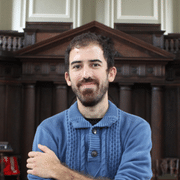
Dr Rafael Romero Garcia
Position: Research Associate
Personal home page:
https://www.bcni.psychol.cam.ac.uk/directory/romero-garcia
PubMed journal articles - click here
Dr Rafael Romero Garcia is pleased to consider applications from prospective PhD students.
Neurosurgical management of brain tumours has entered a new paradigm where resection is extended into the peri-tumoural margin to minimise the potential for recurrence or malignant transformation. Maximising the resection whilst minimising harm is complicated by difficulty in determining the edge of the tumour and limitations in mapping the function of apparently normal brain tissue surrounding the tumour.
Our group aim to address the problem of accurately mapping cognitive functions in a way that is of value to surgeons by using connectomics to create functional and structural 'wiring diagrams' of the brain. Connectomics uses white matter connectivity and the synchronicity of brain signals measured by magnetic resonance imaging (MRI) to model the brain as a continuously interacting communication networks. The way these brain networks are organized is intimately related to cognitive functions, and is believed to be sensitive to changes in these networks due to injury or surgery. Consequently, the hypothesis is that connectomics provides quantitative information on brain networks related to the cognitive functions of individual patients that is valuable to planning tumour resections.
The objective of our research is to derive from pre-operative MRI and connectomic analysis an estimate of the potential risk of resecting tissue in terms of functional loss post-operatively, and from changes in connectomic measure pre- and post-operatively, the likelihood of recovery. We will develop a demonstration system for surgical feedback consisting of a surgical mannequin to which MRI images are mapped and a 3D pointer to orientate the surgeons to the connectomic data. Risk estimates of resecting tissue will come from data collected before and after surgical resection of brain tumours, and up to 12 months following surgery, to discover what properties of the connectome best predict cognitive outcomes and their recovery during rehabilitation. This combined technology will be tested in an observational study for its effectiveness in supporting surgical planning.
Symplectic Elements feed provided by Research Information, University of Cambridge
Romero-Garcia R, Seidlitz J, Whitaker KJ, Morgan SE, Fonagy P, Dolan RJ, Jones PB, Goodyer IM, Suckling J, the NSPN Consortium, Vértes PE, Bullmore ET (2020). Schizotypy-related magnetization of cortex in healthy adolescence is co-located with expression of schizophrenia risk genes. Biological Psychiatry, in Press.
Romero-Garcia R, Erez Y, Oliver BAG, Owen M, Merali S, Poologaindran A, Morris RC, Price S, Santarius T, Suckling J, Hart M (2020). Practical Application of Networks in Neurosurgery: Combined 3D Printing, Neuronavigation, and Pre-Operative Surgical Planning. World Neurosurgery
Hart M*, Romero-Garcia R*, Price S, Suckling J (2018). Global effects of focal tumours on functional complexity and network robustness. Neurosurgery, In Press. *Equally contributed.
Romero-Garcia R, Whitaker KJ, Váša F, Seidlitz J, Shinn M, Fonagy P, Dolan RJ, Jones PB, Goodyer IM; NSPN Consortium, Bullmore ET, Vértes PE (2018). Structural covariance networks are coupled to expression of genes enriched in supragranular layers of the human cortex. Neuroimage, 171:256-267.
Romero-Garcia R*, Warrier V*, Bullmore ET, Baron-Cohen S, Bethlehem RAI (2018). Synaptic and transcriptionally downregulated genes are associated with cortical thickness differences in autism. Molecular Psychiatry, 10.1038/s41380-018-0023-7. *Equally contributed.
Seidlitz J, Váša F, Shinn M, Romero-Garcia R, Whitaker KJ, Vértes PE, Wagstyl K, Kirkpatrick Reardon P, Clasen L, Liu S, Messinger A, Leopold DA, Fonagy P, Dolan RJ, Jones PB, Goodyer IM; NSPN Consortium, Raznahan A, Bullmore ET (2017). Morphometric Similarity Networks Detect Microscale Cortical Organization and Predict Inter-Individual Cognitive Variation. Neuron, 97(1):231-247.e7.
Whitaker KJ, Vértes PE, Romero-Garcia R, Váša F, Moutoussis M, Prabhu G, Weiskopf N, Callaghan MF, Wagstyl K, Rittman T, Tait R, Ooi C, Suckling J, Inkster B, Fonagy P, Dolan RJ, Jones PB, Goodyer IM, Bullmore ET (2016). Adolescence is associated with transcriptionally patterned consolidation of the hubs of the human brain connectome. PNAS, 113:9105-10.















